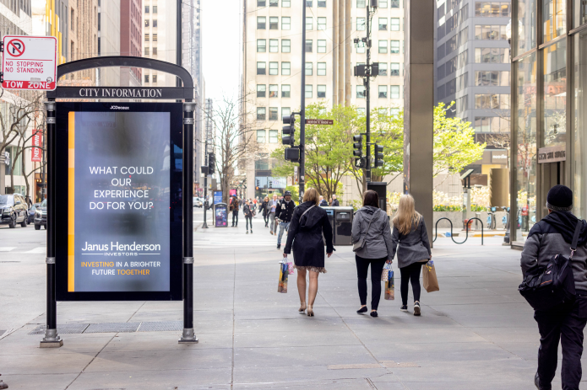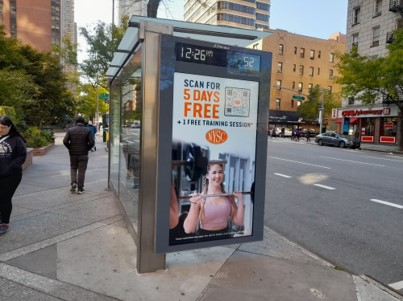Out-of-home advertising, the oldest and most fascinating form of advertising, has always been filled with intriguing terminology. One perfect example of this is the term "Sandwich Boards". Coined by the brilliant Charles Dickens, this term originated from his observation that a person wearing a board on their front and back resembled a delicious sandwich. It's a simple yet enduring term that is still used today. OOH vocabulary has come a long way since then, but there are still some terms that may be unfamiliar to you. One This is just a glimpse into the vast world of OOH vocabulary, but one term that you absolutely must familiarize yourself with is Street Furniture.
What is Street Furniture?
Apart from having the most amusing name for a media format, Street Furniture might conjure up images of a cozy loveseat on the sidewalk waiting to be picked up by the garbage truck. However, Street Furniture is actually one of the most prevalent forms of advertising that we encounter on a daily basis.
Street Furniture refers to the various objects and structures found in public spaces that serve both functional and aesthetic purposes. These include bus shelters, benches, kiosks, trash cans, and bike racks. What makes Street Furniture unique is its strategic placement in high-traffic areas, ensuring maximum visibility and exposure for advertisers. It seamlessly integrates advertising into our urban environments, making it a part of our everyday lives, reaching pedestrians, commuters, and motorists.
Benefits of Advertising on Street Furniture:
-
High Visibility and Reach: Street furniture is strategically positioned in areas with heavy footfall and vehicular traffic, ensuring that brand messages reach a wide and diverse audience. Whether it's a busy downtown intersection or a popular shopping district, these installations capture the attention of passersby. For example, Janus Henderson Investors used digital bus shelters, newsstands, and city information panels in New York and Chicago to create awareness of their long-standing track record and expertise. They focused on media around the financial districts in both cities, targeting financial service professionals as they went to and from work.


-
Contextual Relevance: Successful advertising is all about context. Street furniture advertising enables brands to integrate their messages seamlessly into the urban environment. For instance, an advertisement for a refreshing beverage on a hot summer day can be strategically placed near parks or outdoor seating areas, resonating with the immediate needs of people in the vicinity. Grillo’s Pickles understood the assignment as they say. They wanted people to Chill Out & Eat a Pickle while at the same time providing them a place to Chill Out. Form and function going together just like a Grillo and a BBQ.
.png?width=450&height=337&name=Grillo%20Bench%20(1).png)
- Engagement and Interaction: Street furniture advertisements can be designed to encourage interaction. QR codes or scannable elements on these installations can lead consumers to digital content, promotions, or discounts. This interaction not only enhances engagement but also provides a measurable way to track the effectiveness of the campaign. New York Sports Clubs advertised on transit shelters and kiosks near their NYC locations, showcasing their promotion of 5 free days and 1 free training session at the gym to entice potential members to subscribe. The ad featured an easy-to-use QR code that would allow consumers to sign up immediately.


-
Enhancing Urban Aesthetics: By partnering with local municipalities, brands can contribute to the improvement of urban aesthetics. Well-designed and visually appealing street furniture not only serves its functional purpose but also adds to the overall charm of the city. Brands that prioritize aesthetics are likely to be seen as positive contributors to the community.
- Local Relevance: Brands that understand how consumers move around their environment can use street furniture to convey their message at the perfect time. TIA recently executed a campaign using bus shelters along the route that passes their medical facilities and the ad's messaging referenced the upcoming trip people would be taking to get there. Furthermore, local businesses can benefit immensely by using street furniture to connect with their immediate community and build a strong local customer base. For instance, a neighborhood bakery can promote its freshly baked goods on benches near schools or parks, enticing both children and parents.

-
Non-Intrusive Promotion: In an era where consumers are becoming increasingly adept at avoiding or ignoring traditional advertisements, street furniture advertising provides a less intrusive way of conveying brand messages. These installations become a natural part of the urban environment and are often perceived as less disruptive. In some cases, these advertisements are actually enjoyable. When The Smiths were reissuing their cult classic album The Queen Is Dead, song titles were used as campaign artwork. The campaign included bus benches that were grouped together 10 at a time so that the song titles could be posted in the order in which they appear on the album. This was an extra special "easter egg" for excited fans to discover and garnered the release earned media and social chatter.

Street Furniture is a prime example of how advertising can be seamlessly integrated into our daily lives, creating a symbiotic relationship between brands and consumers. So next time you're out and about, take a moment to appreciate the artistry and effectiveness of Street Furniture as an advertising medium.



